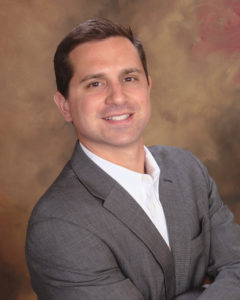[vc_row css_animation=”” row_type=”row” use_row_as_full_screen_section=”no” type=”full_width” angled_section=”no” text_align=”left” background_image_as_pattern=”without_pattern”][vc_column width=”2/3″][vc_column_text]
Presented by

SFBW presented a “Virtual Connect” feature with LevelFunded Health CEO and founder Russ Carpel and COO Jermell Williams. Their company is bringing a fiduciary approach to health care insurance as it helps businesses save money. They offered strong opinions on what’s wrong with the industry and the nation’s health care system.
LevelFunded Health is a national, tech-enabled commercial health insurance distribution platform focused on middle-market employer groups. LFH says it can save midmarket businesses anywhere from $100,000 to more than $2 million a year on health insurance costs and works with over 60 A-rated national insurance carriers.
Carpel is a serial entrepreneur within the insurance vertical and has started two InsureTech platforms. Williams has over 10 years of experience in the employee benefits industry and has worked for major insurance companies.

The webinar on Zoom was moderated by SFBW Editor-in-Chief Kevin Gale. The following highlights have been edited for brevity.
What led you to start LevelFunded?
Carpel: We started this business five years ago. Predominantly, there’s very little government oversight, actually zero government oversight, into intermediaries.
When I mean intermediaries, people who broker or intermediate commercial health insurance products to businesses of any size. Brokers or intermediaries do not have to be held to a fiduciary standard. They don’t have to present or sell or promote products that may be in the best interest of the employer and its employees, which you would think they would have to have given how big the expenses is.
Health insurance is typically the second-, third- or fourth-biggest line expense for any business of any size. So take a 200-person company, for example, that premium would typically be about a million dollars a year between what the employer plays and the employee pays.
What’s happened for decades and decades and decades is, brokers have presented programs and products that have the highest premium because they don’t have to do anything else. And I’m not picking on every single broker in America, but a large percentage of them.
It’s left to be basically just the Wild West. And what you have are premiums that continue to skyrocket. Brokers continue to push programs on companies that yield the highest premium because they don’t have to act as a fiduciary and the higher the premium, the higher the payout to the intermediary, the broker, because they work as a percentage of premium.
We started this because we saw an opportunity where 80 to 90 percent of the middle market was not being presented the products that were the most suitable for them in any particular year. They’re grossly overpaying for commercial health insurance by anywhere from let’s say 10 to 40 percent, which could equate to $100,000 to say $2 million that they’re leaving on the table right now. We built some proprietary software to scour the market.
Jermell, tell us about
what attracted you to joining Russ.
Williams: I’ve been in this space for about 20 years, actually ran my own firms, really successful organizations, and grew extremely fast in the brokerage world in South Florida. I met Russ and understood a lot about his successes with ForeverCar. Also, just seeing somebody outside of this space, look at our space a little bit differently. Ultimately, I believed in the vision. I felt as though LevelFunded Health needed a player on their team that could bring a lot of the technologies and so forth to the platform. Also a lot of insider knowledge on what brokers do, how they go to market. How, from a presentation standpoint with a client, how we’re often inundated to keep the conversation to a minimum, to not show them the full scope of the particular markets and what a client can actually have.
We are fee-based, our fees don’t go up. We make sure that we do what the clients ask us to do year over year making sure that we protect them by keeping their renewals very much mitigated and under control.
It seems to me there’s a real parallel between what you’re doing and what we’ve seen in the investment brokerage business. A lot of people in that field have traditionally been compensated on high-margin products, but certified financial planners are fee-based and have your best interest at heart.
Carpel: I think that’s really the point as to why we started this firm and why we’re having so much success and why we’re so passionate about what we do, because we’re the first to truly do that. I just wish at a macro level that more intermediaries or brokers in the benefit brokerage arena would take that same philosophy, but, unfortunately, most do not.
It’s really left to kind of a Wild West, where the CFOs and the HR folks don’t really know that this is even an issue. Eighty to 90 percent of companies that have 500 or fewer on a medical benefit program are on are what’s called a fully insured structure. That’s just a traditional commercial group health policy. However, 90 percent of employers that have 1,000 or more employees are on what’s known as a self-funded benefit program. Two thirds of the middle market should be on a version of self-funding. And because of the market dislocation like that, you’re basically talking about billions and billions in excess going to fully insured carriers’ top line.
Williams: But imagine if you go and you do your business with your brokerage firm and they meet you year one, and that’s where majority of the work is done. Then imagine year two, where your broker says your renewal got a little bit high. Let’s move some deductibles, which is maybe moving about two or three numbers and moving it up $500 increments or thousand increments at a time. In some instances, you eat that five or 10 percent increase, and what if I told you your broker gets a bonus every time that happens? So, imagine you had a broker for three to five years. Your renewals have been five or six points every year, year over year, and your broker has made more money. Then also at the end of the day, these brokerage firms also receive a business override, which is a bonus. Let’s say year over year, I renew with Blue Cross Blue Shield, a six-point renewal every year. I’m getting a bonus even though I’m doing less work. And then essentially I collect an override now that I’m at year two and three. My book of business has grown and the override for my book of business is almost $2 million or $3 million at a small brokerage firm. How would it behoove me to move business from Blue Cross Blue Shield to Cigna?
What size companies you can handle?
Carpel: We focus on companies, I would say that have anywhere from, let’s say, 50 people on the plan on the very low end up to a couple thousand. We could go bigger, we could go smaller, but that tends to be kind of a sweet spot.
So, you come into an employer. I’m sure there’s some discussion. And I think you guys look at claims history. If I have a workforce that has really higher than average claims, are you still able to handle them?
Williams: If you’re performing badly in your medical and your reimbursements at certain levels to providers, there are reasons why that’s happening. So, a lot of times it’s a matter of taking a look and diagnosing the client. We can mitigate in all situations. If you have a small HR team, and your workers comp is performing pretty bad, then that may be a client that we’ll use our PEO partnerships and put you in that, but ultimately monitor that situation and see also when we can pull you out of the PEO and put you in some of the products that can save you millions. I wouldn’t say that there’s a wrong client for us at all.
So, the name of your company LevelFunded also refers to a broader industry term?
Carpel: Level funding is just immersion of self-funding that strips out the cash flow volatility that would otherwise be there with a traditional self-funded approach. When we started the firm, we knew that level funding was going to continue to get a lot of traction. However, it is just one of the many different things that we do and it is not a one size fit all for every company.
Let’s step back a bit and take a broader look of where we’re at in health care. Any sort of changes that you would like to see?
Williams: I would like to see on a national level where hospitals release costs—what they deem is considered usual and customary in their areas where we’re all able to see it. A lot of people don’t know if I go and get an MRI, let’s say, at my local hospital that’s been around for almost 50-60 years, they may charge me $500 for the MRI. But you know, I go to a brand-name hospital, a lot of people don’t know that they are actually a teaching hospital, which means that the person that’s sitting with you can possibly be within the residency two or three years versus the physician who’s running the machines at the other hospital I spoke of which can be eight years of experience. They’re charging almost sometimes because of their brand name three to four times the amount of what that actual service would cost. And I’m talking about and upwards of, to be literal, sometimes 1,800, 1,900 percent above what a Medicare patient would pay.
It’s really an urgent event at that point in time, where as a consumer, you don’t know the price. Yet you know what you’ll pay. They tell you what your deductible is and you’re out the door. But all of us as employers on the phone here today, what we care about is the bottom line price. You usually don’t know that until you receive the bill.
I know President Trump said he wanted to have more transparency in pricing.
Carpel: Late Q4, there was a lot of buzz around President Trump’s initiatives and thought process around transparency of costs for providers and it can be hospital and outpatient, physician, whatever. I do think that’s a good thing and the right step in the right direction. However, my opinion on this whole industry is, there are backroom deals, there are excess layers of fat in terms of the number of people that touch certain things. It is definitely nothing close to a free market. It is a crony, crony, crony, crony health care system littered with backroom deals on everything.
A lot of people are saying, hey, well, I want socialistic medicine just like happens in other countries, and it’s a fair debate. I don’t necessarily personally agree with it, but I understand where people are coming from. I’m all about liberty, freedom and free markets. And I don’t necessarily like how you have what they call a payer, which is this network or this third party and or insurance companies, sometimes they’re one of the same, are in a backroom deal, let’s say, with a hospital on the front end, deciding what these prices should be for a particular service. To me, that is backward to how the free market is supposed to work. It should be you have some layer of insurance in these—again, this is my personal opinion—outlaw networks, PBMs [pharmacy benefits managers], HMOs, ACOs [accountable care organizations], whatever it may be. If you outlawed all these networks and all these backroom deals, you let the consumer engage directly with hospitals.
And now to Trump’s point, let’s keep it transparent. Now they’re out there with full transparency, shopping for doctors and hospitals and facilities. So instead of the MRI being five grand or 10 grand, what will the market bear, maybe $300 for that service, right? So I’ve talked to a number of doctors and hospitals about the concept. And in theory, they’re like, “Oh, yeah, it’d be great for the consumer, a cost will come down by 90 percent, but I don’t want to be a doctor anymore. I don’t want to go to medical school and take out $500,000 worth of loans, and buy medical malpractice insurance and everything else that comes along with it.”
What I just laid out is a path to actually reduce costs, just because if the payer switches from Blue Cross to Uncle Sam, doesn’t mean your costs are going to come down. If anything, you might be in more of a black hole than you were ever before, because now you have zero transparency.
Now, it’s the one payer, which is the government, with the hospitals and everything else, is just a black hole. And now our taxes all of a sudden are 40, 50, 60, 70 percent, and there’s no end in sight and the only one really winning is the government and the health care providers, right?
So, I think what we need to focus on as business people and try to influence politicians or whatever we can do—even it’s just our own little microcosm of our own employee population—is looking at health care costs. Everything else is bogus. Everything else is really the tail wagging the dog. ♦
[/vc_column_text][/vc_column][vc_column width=”1/3″][/vc_column][/vc_row]
About virtual Connect
SFBW’s Virtual Connect events were created to bring together subject matter experts behind the ever-changing COVID-19 conversation.
The Presenting sponsor was LevelFunded Health. Partnering with SFBW on this event provides an opportunity to network with the area’s business elite, generate new business opportunities and increase brand awareness.
For information about event sponsorship opportunities, email Clayton Idle at Cidle@sfbwmag.com.














